Because yesterday was the 2775th Birthday of Rome, I decided to be Roman in my evening repast.
Spaghetti all’amatriciana. I didn’t have any bucatini, but this bronze-cut high-quality pasta is a principled choice. Actually, it is chitarra.
All’amatriciana is a variant of a much older Roman, Lazio, preparation called “alla gricia”, having just the guanciale and pecorino. Tomatoes are a “New World” thing and didn’t become popularized until a few centuries after Columbus, bless him. There is a fascinating little book about the history of the tomato. A great read. Get it with my affiliate link.
 Pomodoro!: A History of the Tomato in Italy (Arts and Traditions of the Table Perspectives on Culinary History)
Pomodoro!: A History of the Tomato in Italy (Arts and Traditions of the Table Perspectives on Culinary History)
The set up. The pasta, some San Marzano tomatoes (thanks to a reader), guanciale (thanks to a reader, grated pecorino (thanks to a reader), white wine and olive oil. That’s about it.
You don’t have to have San Marzano. Fresh tomatoes, peeled and seeded are the true foundation. In a pinch use canned.
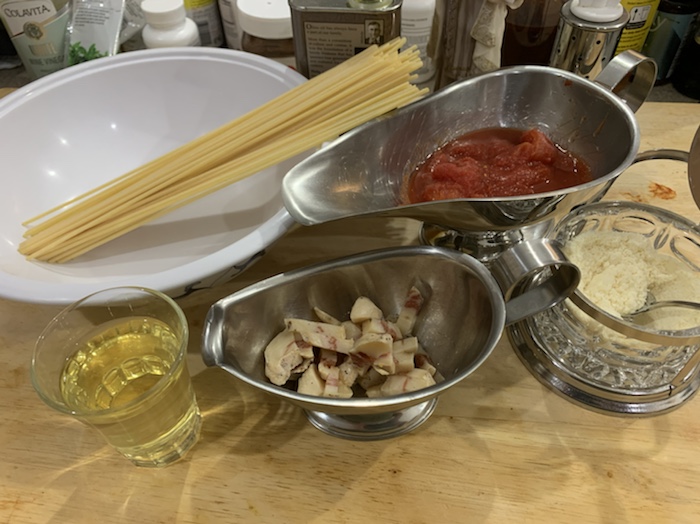
Start the guanciale in some oil. I had a little too much and extracted a bit.
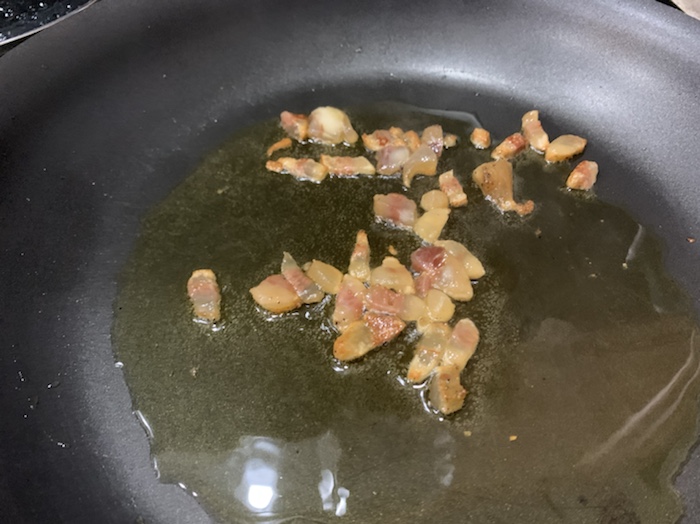
Pull them out and keep them warm.
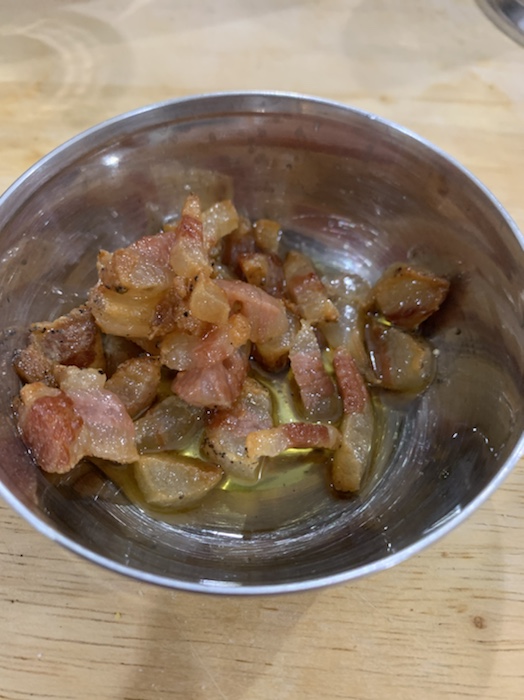
Work the tomatoes.
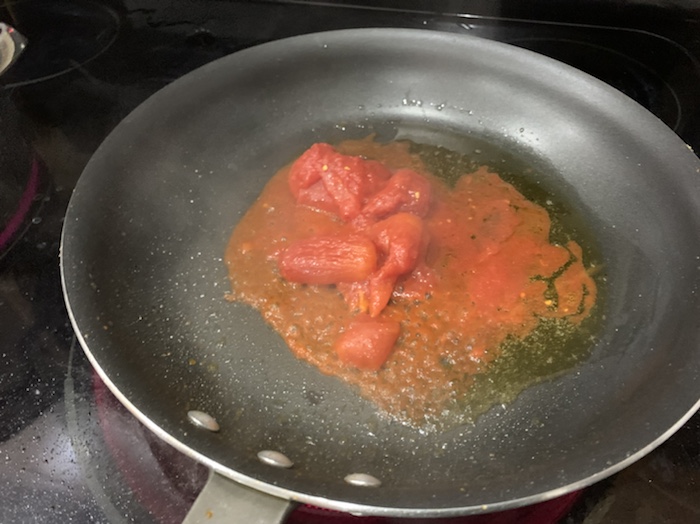
A touch of wine and reduce.
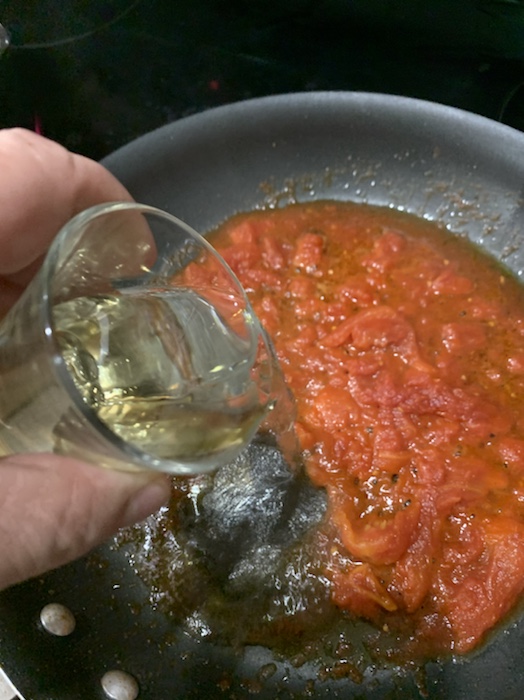
Oh yes, I added a little pepperoncino.
Join together the guanciale and your al dente pasta, to finish cooking the pasta in the sauce. I added just a little of the starchy pasta cooking water.
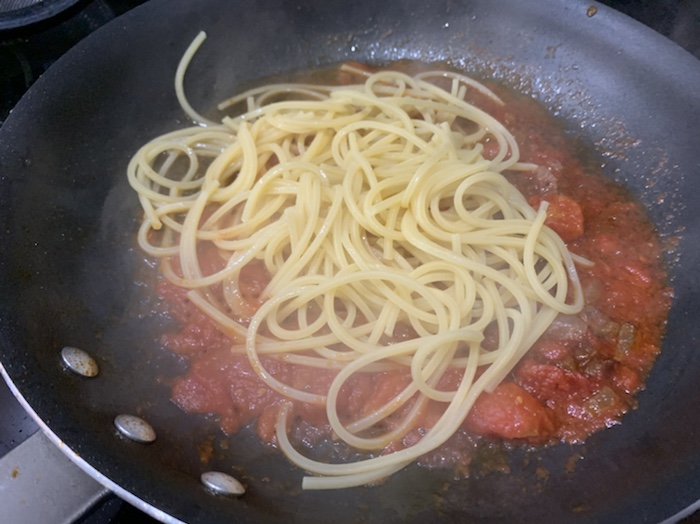
Supper. Very easy. Super fast. You can do it too.
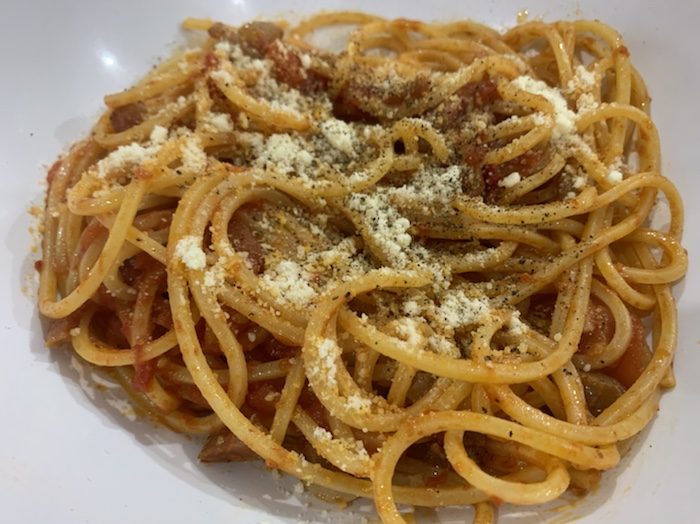
A grind of pepper and pecorino.
Remember that your pasta is a significant percentage of the food in that bowl. Therefore, you should get good pasta for a good meal. Remember, too, that the pasta will pick up what your water tastes like. If you have awful water, you will have sub-optimal pasta. Use bottled water if your water is dreadful and see if there isn’t a difference.
Guanciale… from the cheek or jowl of the pig. Essential? Yes and no. Can you use pancetta? Okay, but it won’t be quite the same. Guanciale has a different texture, mouth feel, flavor. BUT… we mustn’t let the perfect be the enemy of the good. You can make a great bowl of pasta with what you have on hand. Improvise, adapt, overcome.


































Guanciale? I’ve never heard of that! I’ll have to look that up the next time we butcher a pig. Soon, I hope. We love experimenting with different types of cured meat. So far lardo, aged hung bacon, is my favorite but guanciale looks tempting!
Where does one get good pasta (assuming one doesn’t make it oneself)?
You once mentioned that the garlic in these United States is “weak”. Is there a way to get good garlic?
i have some good hothouse tomatoes on hand that are now nicely ripe. tomorrow will either be this or alla’norma
I share your cooking blogs with my children who all love to cook. So much of what you make is what my dearly departed Mother made. My Aunt was my last surviving source for recipes and in typical Sicilian fashion would leave something out when giving me the recipe. Trial and error became fun over the years trying to figure out the missing ingredient. It took me years to figure out St. Joseph’s pasta. Anise bulbs, cauliflower, fave beans. It was called a poor man’s sauce because it had no tomatoes. The secret is to puree the anise bulbs and cauliflower which makes a thick sauce. Keep them coming Father.
What, no selections from Apicius??!!
[No!! No selections from Apicius. I was fresh out of doormice, Smarticus Pantsicus, and the flamingos are just to wary. I will have you know, however, that I have had a several course meal entirely from the De re coquinaria at one of Grant Achatz restaurants. So there. And, yes, it was amazing. How ’bout a little piggy?]
Father, since (a) you’re celebrating Rome’s birthday, (b) are heading to Rome, (c) know and love Latin, and (d) are an expert libationist (if that’s not a word, it should be!), I thought you and fellow readers would get a smile out of this:
:-)
NOT: you’ve got me stumped! What are anise bulbs? I thought anise was a simple seed used in cooking, so where do the bulbs come from? Did you mean garlic?
ma dov’è la cipolla? :(
The real thing does not have onion. Sometimes in Rome a little onion sneaks in, and it isn’t bad at all, but the real thing doesn’t have onion, just those basics – very simple and with the proper technique.
The jury is out on that, Father. There are quite a few interesting articles on this topic. I will admit that the _original_ ancient recipe did not have onion. But it made its way in by “organic development” if you will…. :)
[If I will? No, I won’t. The addition of onion makes a tasty plate of food, no question. I’ve occasionally thrown in some onion that needed to be used up. However, the DOC amatriciana is without onion. Maybe I could call with onion amatriciana* or maybe @matriciana.]